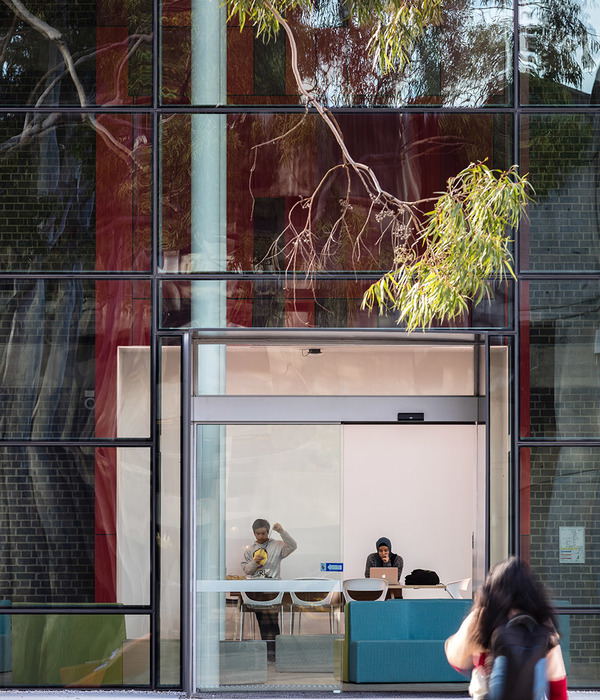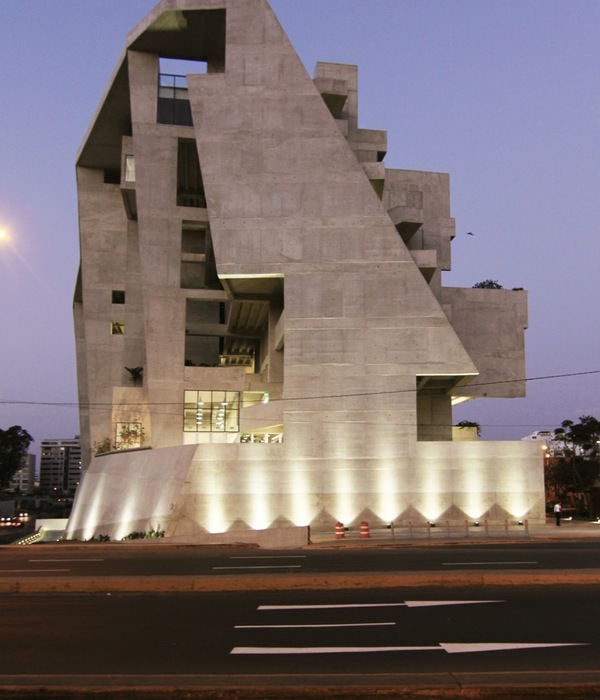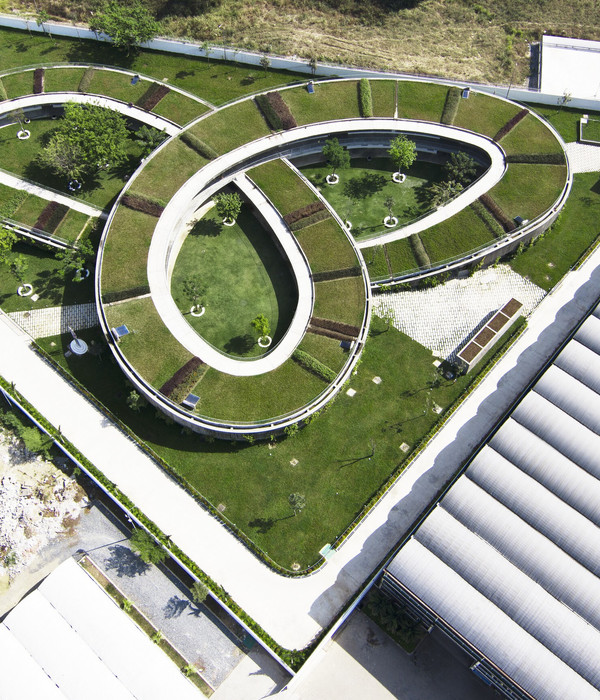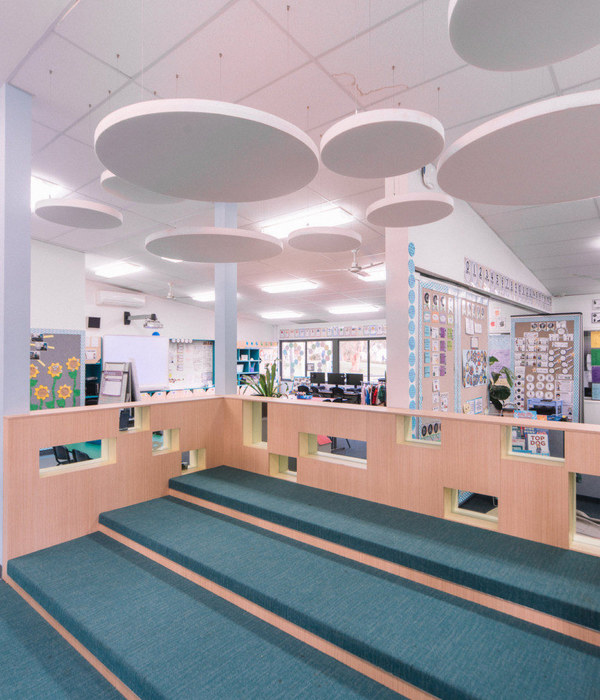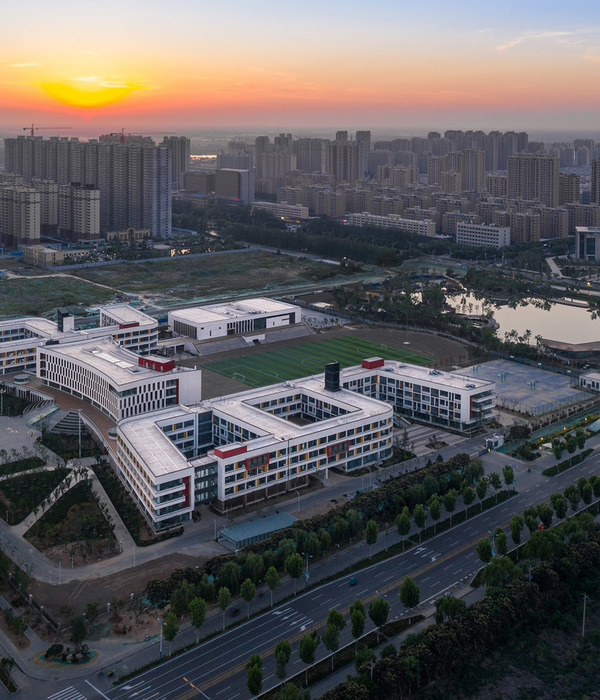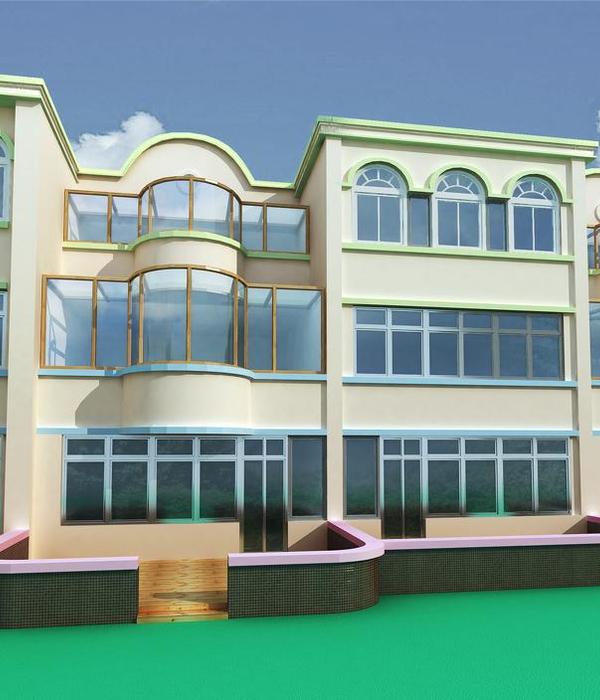德克萨斯大学奥斯汀分校的Cookrell工程学院于2011年9月28日举办了多学科教学与研究中心EERC的开幕仪式,该中心面积为432,500平方英尺。项目由Ennead建筑师事务所与雅各布工程集团公司共同设计。EERC在UT Austin校园创造了一个动态的、统一的工程创新中心,它将与Cookrell学院的全球声誉和抱负相匹配。Ennead设计合伙人Todd Schliemann和管理合伙人Kevin McClurkan领导了Ennead团队。雅各布斯团队由负责人Bryan Floth领导。
September 28, 2017-Today the Cookrell School of Engineering at the University of Texas at Austin celebrated the opening of a new 432,500 square foot multidisciplinary teaching and research facility, the Engineering Education and Research Center (EERC), designed by Ennead Architects with Jacobs Engineering Group, Inc. The EERC creates a dynamic and unifying new hub for engineering innovation on the UT Austin campus, one that matches the global reputation and ambition of the Cockrell School. Ennead Design Partner Todd Schliemann and Management Partner Kevin McClurkan led the Ennead team. The Jacobs team was led by Principal-in-Charge Bryan Floth.
▼外观一览,overview
在7年多的时间里,EERC通过结合本科基于项目的学习和跨学科的研究生学习,与艺术教室、大型实验室和创客空间一起,定义了一种新的工程教育方法。它包括23000平方英尺的国家仪器学生项目中心,将最先进的设计工具提供给工程研究的本科生,还有James J. And Miriam B. Mulva礼堂和会议中心,这是Cockrell学院最大的活动空间。除此之外,学校在德州仪器教学和项目实验室与创新中心培养学生们的领袖精神,提高革新思想应用到市场上的速度。
大楼入口,the entrance of the building
Todd Schliemann说:“工程的潜在应用与许多复杂的急需解决的问题一起扩大着。我们设计了EERC,以应对越来越多的协作领域的挑战,通过建筑增强社区的可视性和共享空间。我们认识到创新需要多个视角,因此,EERC被设计成一个鼓舞人心的学习空间,鼓励工程领域问题的下一代解决者之间能够进行更多的合作。”
Todd Schliemann remarks, “The potential applications for engineering continue to expand, in step with the many complex, urgent problems in need of new approaches. We designed the EERC to meet the challenges of an increasingly collaborative field through architecture that reinforces community through visibility and shared space. Recognizing that Innovation requires multiple perspectives, the EERC was conceived as an inspiring learning space to encourage greater collaboration between the next generations of problem solvers in this field.”▼三层高的内部中庭,the three-story high inner courtyard
▼中庭内的连桥,the bridge crosses over the courtyard
考虑到学校的战略和规划需求,这栋建筑被分成了两个9层的石灰岩大楼和玻璃塔,满足了电子和计算机工程学院和跨学科研究生研究的实验室、办公室和工作空间的不同要求。这两座塔楼有着面向内部的玻璃幕墙立面,并由一个封闭的三层高的中庭相连接。中庭有一个用玻璃和钢制作的折叠的屋顶,创造出充满活力的、充满阳光的公共空间,这是建筑的社交中心,旨在促进教师、员工、学生和校园访客之间的交流。桥梁和楼梯创造了循环路径,与不同的科研环境相连。透过中庭北侧的落地窗可看到国家仪器学生工程中心,致力于以项目为基础的跨学科学习。裸露混凝土的真实表达,未加遮掩的机械系统以及房间之间的玻璃墙充分展示了工程和工程教育。整个建筑的姿态都是为了突显工程学之美:从横跨塔的钢桁架系统到错综复杂的螺旋梯;从楼梯下精致的“V”柱,到连接楼层的天桥。
Given the school’s strategic and programmatic needs, the building is organized into two nine story limestone and glass towers, acknowledging the substantially different requirements for labs, offices and work spaces of the Department of Electrical and Computer Engineering and interdisciplinary graduate research. The two towers, with inwardly-oriented glass curtain wall facades, are connected by an enclosed three-story atrium with a folded glass and steel roof, creating vibrant, light filled public space, which is the social heart of the building meant to facilitate “productive collisions’ between faculty, staff, students and campus visitors. Bridges and staircases create circulation paths throughout and join the different research environments. Prominently visible through floor-to-ceiling glass along the north wall of the atrium is the National Instruments Student Project Center, dedicated to project-based interdisciplinary learning. Its honest expression of raw concrete, fully exposed mechanical systems, and glass walls from room to room puts engineering and engineering education, on full display. Architectural gestures throughout the building were designed to elevate and celebrate engineering principles – from the steel truss systems spanning the towers to the intricate spiral staircase, from the delicate “V” column underneath the staircase to the sky bridges connecting the floors.
▼折叠状的不锈钢和玻璃天花板,folded glass and steel roof
楼梯的设计透露浓浓的技术美感,the design of the stairs reveals the aesthetics of technology
“V”柱细节,details of the delicate “V”column
Ennead项目设计师Alex O’briant解释说,这个项目的设计是从建立基础驱动器开始的,就像编程一样,有两个研究环境必须以特定的方式运作。所有其他的建筑移动都是为了连接这两个塔楼,并通过一系列统一的姿态和强调透明度将这些精心设计的隔间结合成一个单一的、有凝聚力的工程社区。我们创造了物理和视觉的连接,并将它们固定在建筑物中心的一个巨大的、开放的、充满阳光的并能看到建筑物内所有活动的中庭。
Ennead Project Designer Alex O’Briant explains, "The design of this project began with establishing the basic drivers, as programmatically there were two research environments that had to function in specific ways. Every other architectural move was made to undo the separation of the two towers and stitch these carefully crafted compartments together into one single cohesive engineering community, through a series of unifying gestures and an emphasis on transparency. We created physical and visual connections throughout and anchored them with a massive, open, light-filled atrium at the center of the building that exposes all the layers of activity going on within the building."
两个塔楼内部面对着的玻璃立面,the inward glass facades of the two buildings
▼立面强调透明度,the facade highlights the transparency
EERC为Cookrell学院提供了一个集中式的新家,定义了德州奥斯汀大学的工程学区,激活了校园的边缘,并在该区域的当代建筑和核心校园之间起到了协调作用。EERC通过一系列舒适的空间排列来化解场地到Waller河之间将近30英尺(约10米)的高差,并在其间制造了多个到达新校区的通道。建筑和景观的综合设计包括了隐蔽的步行道、开放的景观空间和入口处层高的退让,是用现代的手法来呼应历史悠久的校园。设计中使用的德州当地的石灰石和不锈钢与锌制的装饰性金属工艺都展现着传统校园的风貌。
The EERC provides a centralized new home for the Cookrell School and defines the engineering precinct at UT Austin, activating that edge of campus and mediating between the contemporary buildings in the area and the core campus. With a comfortably-scaled sequence of spaces, the EERC mitigates a thirty foot grade change across the site to Waller Creek while creating new campus connections and routes of access. The integrated building and landscape design, including shaded walkways and landscaped open spaces and a height setback for the entry, reference the historic campus using modern idioms. The building materials likewise hearken to the traditional campus with the use of local Texas limestone and ornamental metal work in stainless steel and zinc.
▼连接两个楼梯的多个廊道通过V柱稳定结构,并成为大楼主立面的特色;the bridges connecting the two building blocks are stabled by the V columns structurally and together form a unique look for the main facade of the whole building
▼露台上通透明亮的景色,the bright and airy view on the terrace
▼学习区域的天花板未进行更多的遮盖,将机械部分完全暴露出来;
the mechanical part of the ceilings in the study area are exposed
▼为于楼后的室外休闲交流空间,an outdoor space for relax and communication behind the main building
EERC是一个高性能建筑,获得了LEED Silver认证。它采用了许多可持续的设计策略,包括优化的太阳能定位和一个复杂的基于可持续性分析而定制的遮阳系统,它能最大化自然光和舒适性,同时在高强度的太阳环境下减少热量的增加。该建筑有自动空气质量传感器,可以调节实验室的空气变化速度,还有雨水管理系统,以及屋顶花园。
A high performance, LEED Silver building, the EERC employs many sustainable design strategies, including optimized solar orientation and a sophisticated, customized sun shading system based on sustainability analytics that maximizes natural light and comfort while minimizing heat gain in the high-intensity solar environment of Austin sun. The building has automated air quality sensors that adjust the rate of air changes in the labs, storm water management systems, and planted rooftops.
▼夜色下的大楼,the building at night
Ennead Architects(设计师)Jacobs(执行建筑师)– 8层
– 130名教职员工办公室
- James J. and Miriam B. Mulva礼堂298个座位- 8,118名学生- 国家仪器学生项目中心23,000平方英尺的开放式设计空间- 432,500平方英尺的空间- 6500万美元募捐款,来自德克萨斯州280多名工程支持者(有史以来获得最多支持的UT Austin大楼)
Ennead Architects (Design Architect)Design Partner – Todd Schliemann
Management Partner – Kevin McClurkan
Project Designer – Alex O’Briant
Project Manager / Project Architect – Emily Kirkland
Project Architect, Design – Megan Miller
Interiors – Charmian Place
Design Team – Zach Olczak, Jena Rimkus, Gary Anderson, James Rhee, Shawn Whitehead, Darla Elsbernd
Jacobs (Executive Architect)Principal – Bryan Floth
Senior Project Architect – Nathan Carruth
Project Architect – Ron Seder
Project Manager Phase 1 – David Gustaf
Project Manager Phase 2 – Rob Dilling
Project Manager Remobilization – Chris Davis
Senior Construction Project Manager – Ken Houghton
Construction Project Manager – Amanda Walker
Senior BIM Manager – Robert Mooney
Project Team – Sina Ajayi, Jake McKinney
Executive Vice President – Chuck Nixon
Completed: September 2017
Location: Austin, TX
Size: 432,500 GSF
Program: Interdisciplinary Research Laboratories, Teaching Laboratories, Auditorium, Classrooms, Meeting Facilities, Central Atrium, Centralized Student Services
EERC by the numbers:– 8 Stories high
– 130 Faculty and staff member offices
– 298 Seats in the James J. and Miriam B. Mulva Auditorium
– 8,118 Cockrell School students who will benefit from the EERC
– 23,000 Total square feet of open design space in the National Instruments Student Project Center
– 432,500 of space in the EERC
– $65 million Raised from over 280 Texas Engineering supporters (most ever raised in support of a UT Austin building)
{{item.text_origin}}



